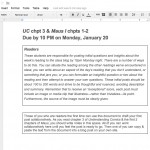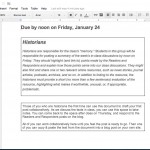As described on the course guidelines, every student will rotate through three different blogging roles throughout the semester. There will be 4 students in each group, and there will be a stable rotation throughout the roles.
Here are more details about what I expect from each role:
Readers
These students are responsible for posting initial questions and insights about the week’s reading to the class blog by 10pm Monday night. There are a number of ways to do this. You can situate the reading among the other readings we’ve encountered in class; you can write about an aspect of the day’s reading that you don’t understand, or something that jars you; or you can formulate an insightful question or two about the reading and then attempt to answer your own questions. These initial posts should be about 100 to 200 words and strive to be thoughtful and nuanced, avoiding description and summary. Remember that to receive an “exceptional” score, each post must include an image or media clip that illustrates—rather than trivializes—its point. Furthermore, the source of the image must be clearly given.
Responders
Students in this group will build upon, disagree with, or clarify either a reader post or something from Tuesday’s class discussion, by 10pm Wednesday night. These posts should be about 100 to 200 words. Remember that to receive an “exceptional” score, each post must include an image or media clip that illustrates—rather than trivializes—its point. Furthermore, the source of the image must be clearly given.
Historians
Historians are responsible for the class’s “memory.” Students in this group will be responsible for posting a summary of the week’s in-class discussions by noon on Friday. They should highlight (and link to) points made by the Readers and Responders and explain how those points came into our class discussions. They might also find and share one or two relevant online resources, such as news stories, journal articles, podcasts, archives, and so on. In addition to linking to the resource, the historians must provide a short (no more than a few sentences) evaluation of the resource, highlighting what makes it worthwhile, unusual, or, if appropriate, problematic.
Nuts & Bolts
Once you have set up your domain with Reclaim Hosting and installed WordPress, I’ll collect the address for the site from each of you. Someone from each group will post on his or her own site and I’ll use a syndication plugin called FeedWordPress to stream the individual posts you write onto our class blog automagically.
When you publish your post, your title should start with the name of your role for the week, followed by a unique title for that post (i.e., “Readers: Making sense of the first chapters of Maus“). You should assign each of these posts with the appropriate category: Readers, Responders, or Historians. (Here’s the WordPress help page on using categories. When you are first setting up your WordPress blog, you should go ahead and create each of those three categories. We’ll talk about this in class.)
I’ll help you set up a system for drafting these posts collaboratively using Google drive. I’ve set up documents for the first go round for each of these groups and I’ll share them with you. They look like this (click to “embiggen”):
Blog post grade scale
| Rating | Characteristics |
| 16 | Exceptional. The journal entry is focused and coherently integrates examples with explanations or analysis. The entry demonstrates awareness of its own limitations or implications, and it considers multiple perspectives when appropriate. The entry reflects in-depth engagement with the topic. |
| 12 | Satisfactory. The journal entry is reasonably focused, and explanations or analysis are mostly based on examples or other evidence. Fewer connections are made between ideas, and though new insights are offered, they are not fully developed. The entry reflects moderate engagement with the topic. |
| 8 | Underdeveloped. The journal entry is mostly description or summary, without consideration of alternative perspectives, and few connections are made between ideas. The entry reflects passing engagement with the topic. |
| 4 | Limited. The journal entry is unfocused, or simply rehashes previous comments, and displays no evidence of student engagement with the topic. |
| 0 | No Credit. The journal entry is missing or consists of one or two disconnected sentences. |



1 Response